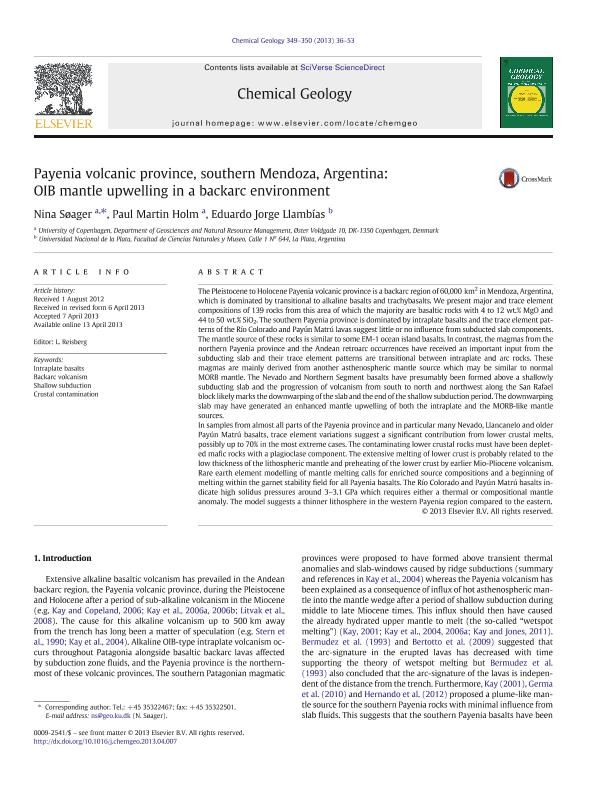Mostrar el registro sencillo del ítem
dc.contributor.author
Soager, Nina
dc.contributor.author
Holm, Paul Martin
dc.contributor.author
Llambias, Eduardo Jorge

dc.date.available
2017-09-15T16:54:41Z
dc.date.issued
2013-06
dc.identifier.citation
Soager, Nina; Holm, Paul Martin; Llambias, Eduardo Jorge; Payenia volcanic province, southern Mendoza, Argentina: OIB mantle upwelling in a backarc environment; Elsevier Science; Chemical Geology; 349-350; 6-2013; 36-53
dc.identifier.issn
0009-2541
dc.identifier.uri
http://hdl.handle.net/11336/24368
dc.description.abstract
The Pleistocene to Holocene Payenia volcanic province is a backarc region of 60,000 km2 in Mendoza, Argentina, which is dominated by transitional to alkaline basalts and trachybasalts. We present major and trace element compositions of 139 rocks from this area of which the majority are basaltic rocks with 4 to 12 wt.% MgO and 44 to 50 wt.% SiO2. The southern Payenia province is dominated by intraplate basalts and the trace element patterns of the Río Colorado and Payún Matrú lavas suggest little or no influence from subducted slab components. The mantle source of these rocks is similar to some EM-1 ocean island basalts. In contrast, the magmas from the northern Payenia province and the Andean retroarc occurrences have received an important input from the subducting slab and their trace element patterns are transitional between intraplate and arc rocks. These magmas are mainly derived from another asthenospheric mantle source which may be similar to normal MORB mantle. The Nevado and Northern Segment basalts have presumably been formed above a shallowly subducting slab and the progression of volcanism from south to north and northwest along the San Rafael block likely marks the downwarping of the slab and the end of the shallow subduction period. The downwarping slab may have generated an enhanced mantle upwelling of both the intraplate and the MORB-like mantle sources. In samples from almost all parts of the Payenia province and in particular many Nevado, Llancanelo and older Payún Matrú basalts, trace element variations suggest a significant contribution from lower crustal melts, possibly up to 70% in the most extreme cases. The contaminating lower crustal rocks must have been depleted mafic rocks with a plagioclase component. The extensive melting of lower crust is probably related to the low thickness of the lithospheric mantle and preheating of the lower crust by earlier Mio-Pliocene volcanism. Rare earth element modelling of mantle melting calls for enriched source compositions and a beginning of melting within the garnet stability field for all Payenia basalts. The Río Colorado and Payún Matrú basalts indicate high solidus pressures around 3–3.1 GPa which requires either a thermal or compositional mantle anomaly. The model suggests a thinner lithosphere in the western Payenia region compared to the eastern.
dc.format
application/pdf
dc.language.iso
eng
dc.publisher
Elsevier Science

dc.rights
info:eu-repo/semantics/openAccess
dc.rights.uri
https://creativecommons.org/licenses/by-nc-sa/2.5/ar/
dc.subject
Intraplate Basalts
dc.subject
Backarc Volcanism
dc.subject
Shallow Subduction
dc.subject
Crustal Contamination
dc.subject.classification
Oceanografía, Hidrología, Recursos Hídricos

dc.subject.classification
Ciencias de la Tierra y relacionadas con el Medio Ambiente

dc.subject.classification
CIENCIAS NATURALES Y EXACTAS

dc.title
Payenia volcanic province, southern Mendoza, Argentina: OIB mantle upwelling in a backarc environment
dc.type
info:eu-repo/semantics/article
dc.type
info:ar-repo/semantics/artículo
dc.type
info:eu-repo/semantics/publishedVersion
dc.date.updated
2017-09-14T13:53:24Z
dc.journal.volume
349-350
dc.journal.pagination
36-53
dc.journal.pais
Países Bajos

dc.journal.ciudad
Amsterdam
dc.description.fil
Fil: Soager, Nina. Universidad de Copenhagen; Dinamarca
dc.description.fil
Fil: Holm, Paul Martin. Universidad de Copenhagen; Dinamarca
dc.description.fil
Fil: Llambias, Eduardo Jorge. Universidad Nacional de La Plata. Facultad de Ciencias Naturales y Museo; Argentina. Consejo Nacional de Investigaciones Científicas y Técnicas; Argentina
dc.journal.title
Chemical Geology

dc.relation.alternativeid
info:eu-repo/semantics/altIdentifier/doi/http://dx.doi.org/10.1016/j.chemgeo.2013.04.007
dc.relation.alternativeid
info:eu-repo/semantics/altIdentifier/url/http://www.sciencedirect.com/science/article/pii/S0009254113001502
Archivos asociados
